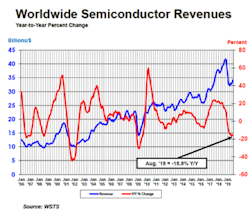Bullish on 2020: One-on-One with Karim Yasmine, Future Electronics
What goes up, must come down. That about sums it up when it comes to current conditions in the global electronic component market.
According to recent figures from WSTS, the worldwide semiconductor market growth rate was up 13.7% in 2018, an all-time high, and is forecast to be down 13.3% in 2019, with every geographic region expected to be in negative territory. The Americas are forecast to post the biggest decline for 2019 at 27.3%.
This year’s downward slide is comparable in magnitude with the decline during the 2008 Great Recession (see figure). But just as the market bounced back fast and strong in 2009, many industry veterans expect a similar rebound in 2020. Nevertheless, the latest WSTS forecast is not quite as optimistic, putting year-on-year semiconductor growth for 2020 up by 4.8%.
“2019 is a bit of a reset year, coming off a strong allocated market in 2018 where customers loaded up on a significant amount of inventory to protect themselves,” said Future Electronics’ Karim Yasmine, corporate vice president of strategic supplier development. Layered on top of the cyclical downturn was the imposition of tariffs, which had a multiplier effect on the sales slowdown as OEMs and EMS providers bulked up before the tariffs were imposed, which added to the inventory glut.
The bright side in 2019 has been the amount of design activity, according to Yasmine. Future monitors its customers’ new design starts closely—how many new projects have been launched and in what market segments—as they are the feedstock for future component sales. “It’s been an incredible year for new designs, so there’s an upside to the way the business feels right now,” said Yasmine.
One of the most active areas of new design is transportation, which includes autonomous technologies, battery management, and charging stations. “These days, design is about smart-everything,” Yasmine noted. “Artificial intelligence, machine learning, and robotics are all booming.
“We think the chip industry will come roaring back in 2020, and it will be a nice recovery year for the electronics sector. We are well-positioned on the supply chain solution side and on the design conversion side,” he continued. “On the design-conversion side, we will continue to outperform market expectations.”
In addition to its team of generalist FAEs, Future employs specialist engineers for wireless, security, and other focused applications. The company also has a small number of design engineers specifically tasked with helping customers accelerate design conversion for custom applications.
Today, Future is focused on ensuring the engineering team has the right skills and expertise that will be required to deal with the complexity of product design in the next five years. Yasmine’s list of technologies includes the usual suspects: autonomous and electric vehicle technologies, IoT, 5G, AI and ML, and robotics.
As far as where Future is focusing its design engineering investments, Yasmine was less than forthcoming: “We have some conceptual ideas for what we want to do in the next three to five years, but I’ll keep them to myself for the time being.”
One market of focus for Future is automotive, with substantial growth opportunities in Southeast Asia, including Vietnam, Malaysia, Cambodia, Laos, and Singapore. The primary reason for the optimistic outlook is the migration of manufacturing out of China, according to Yasmine.
Future is closely monitoring the trade battle between the U.S. and China and the dynamics of the Chinese marketplace. Also, it is keeping an eye on new Chinese semiconductor manufacturers that are emerging rapidly. “We are starting to see a lot of customers mentioning Chinese-grown chip manufacturers that are not your run-of-the-mill semiconductor companies,” Yasmine revealed.
And then there’s the political wildcard. On Future’s watchlist is the tariff war between the U.S. and China, the Brexit deal, and tensions between Korea and Japan. Any of these could impact how 2020 unfolds, either negatively or positively.
Still, Future remains bullish on 2020. “We think we’ve well positioned to outgrow market expectations in the short-term both on the supply chain solution side and on the design-conversion side,” Yasmine said.










